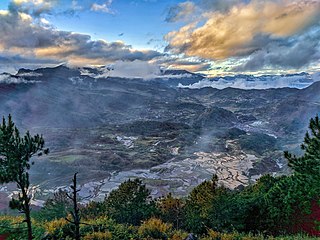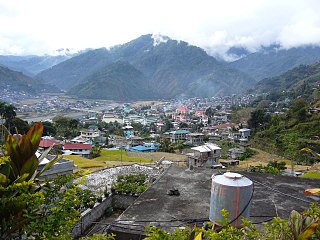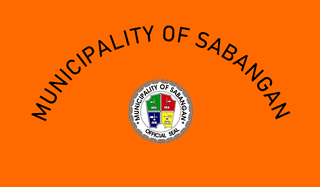
Mountain Province is a landlocked province of the Philippines in the Cordillera Administrative Region in Luzon. Its capital is Bontoc.

Kalinga is a landlocked province in the Philippines situated within the Cordillera Administrative Region in Luzon. Its capital is Tabuk and borders Mountain Province to the south, Abra to the west, Isabela to the east, Cagayan to the northeast, and Apayao to the north. Kalinga and Apayao are the result of the 1995 partitioning of the former province of Kalinga-Apayao which was seen to better service the respective needs of the various indigenous peoples in the area.

The Cordillera Administrative Region, also known as the Cordillera Region, or simply, Cordillera, is an administrative region in the Philippines, situated within the island of Luzon. It is the only landlocked region in the insular country, bordered by the Ilocos Region to the west and southwest, and by the Cagayan Valley Region to the north, east, and southeast. It is the least populous region in the Philippines, with a population less than that of the city of Manila.

The indigenous peoples of the Cordillera Mountain Range of northern Luzon, Philippines are often referred to using the exonym Igorot people, or more recently, as the Cordilleran peoples. There are nine main ethnolinguistic groups whose domains are in the Cordillera Mountain Range, altogether numbering about 1.5 million people in the early 21st century.

Bauko, officially the Municipality of Bauko is a 4th class municipality in the province of Mountain Province, Philippines. According to the 2020 census, it has a population of 32,021 people.

Bontoc, officially the Municipality of Bontoc, is a 2nd class municipality and capital of the province of Mountain Province, Philippines. According to the 2020 census, it has a population of 24,104 people.

Sabangan, officially the Municipality of Sabangan is a 5th class municipality in the province of Mountain Province, Philippines. According to the 2020 census, it has a population of 9,621 people.

Sadanga, officially the Municipality of Sadanga is a 5th class municipality in the province of Mountain Province, Philippines. According to the 2020 census, it has a population of 8,427 people. Sadanga boundaries both provinces are Abra to the northwest & west and Kalinga to the north & northeast.

Sagada, officially the Municipality of Sagada is a 5th class municipality in the province of Mountain Province, Philippines. According to the 2020 census, it has a population of 11,510 people.

The Kalinga people are an indigenous ethnic group whose ancestral domain is in the Cordillera Mountain Range of the northern Philippines. They are mainly found in Kalinga province which has an area of 3,282.58 sq. km. Some of them, however, already migrated to Mountain Province, Apayao, Cagayan, and Abra. The Kalinga numbered 163,167 as of 2010.

Mount Binuluan is a remote volcano in the Kalinga province of the Cordillera Administrative Region of the Philippines. The 2,329-metre-high (7,641 ft) mountain is part of the Cordillera Central mountain range on Luzon island, the largest island in the country. Binuluan exhibits active volcanism through numerous fumarole fields, solfataras and hot springs on its slope. There were reports of possible eruptions in 1952 and 1986, but they are unverified.

Macli-ing Dulag was a pangat (leader) of the Butbut tribe of Kalinga province in the Philippines. He is best as one of the leaders of the opposition to the Chico River Dam Project, which led to his assassination by armed forces under the command of then-dictator Ferdinand Marcos.

The Bantayog ng mga Bayani, sometimes simply referred to as the Bantayog, is a monument, museum, and historical research center in Quezon City, Philippines, which honors the martyrs and heroes of the struggle against the dictatorship of former President Ferdinand Marcos.
Antonio Ma. "Tony" Onrubia Nieva was a Philippine journalist, union organizer, and activist. He worked to defend press freedom and the rights of workers, and campaigned to end dictatorship in the Philippines. He led the National Press Club as president and founded the National Union of Journalists of the Philippines. He was secretary general of the International Organization of Journalists based in Prague, Czech Republic, from 1995 up to the time of his death in 1997. His name is on the Bantayog ng mga Bayani Wall of Remembrance, for his contributions to the fight against injustices of the dictatorship under President Ferdinand E. Marcos.

Religious sector opposition against the dictatorship of President Ferdinand Marcos included leaders and workers belonging to different beliefs and denominations.
The dictatorship of Philippine President Ferdinand E. Marcos in the 1970s and 1980s is historically remembered for its record of human rights abuses, particularly targeting political opponents, student activists, journalists, religious workers, farmers, and others who fought against the Marcos dictatorship. Based on the documentation of Amnesty International, Task Force Detainees of the Philippines, and similar human rights monitoring entities, historians believe that the Marcos dictatorship was marked by 3,257 known extrajudicial killings, 35,000 documented tortures, 77 'disappeared', and 70,000 incarcerations.
During the presidency of Ferdinand Marcos, Filipino workers in the labor industry experienced the effects of government corruption, crony capitalism, and cheap labor for foreign transnational industries, One of the objectives of Martial Law was to cheapen labor costs, in order to attract transnational corporations to export labor to the Philippines. Marcos signed many presidential decrees beneficial only to his associates, while allowing for the forced relocation of indigenous peoples, decreasing workers' wages, and murders of labor activists. Minimum wage was a fixed PHP8.00 per day. Many workers were unemployed or underemployed. It was also during the Marcos presidency when the practice of contractualization began, enabling managements to avoid giving regular, permanent status to employees after six months of work. Strikes were banned and the government controlled trade unions, leaving workers without effective protection against employers who had unfair labor practices and regulations.
Purificacion Pedro, also known by her nickname as "Puri Pedro," was a Filipino social worker and Roman Catholic layperson who was killed by soldiers under the dictatorship of former Philippine president Ferdinand Marcos at the Bataan Provincial Hospital in 1977.

Indigenous people’s resistance against the Marcos dictatorship varied from case to case among the various indigenous peoples of the Philippines. The most documented cases are the various resistance movements towards the Marcos administration’s appropriation of indigenous lands, particularly in the case of the Chico River Dam Project and the Manila Water Supply III project on the Kaliwa River watershed, and the birth of the various separatist groups and their coalescing into the Moro conflict in the wake of news about the Jabidah Massacre.
Maria Ceres P. Doyo is a Filipino journalist, author, human rights activist, and feminist best known as a columnist and staff writer for the Philippine Daily Inquirer, for her numerous books on Philippine journalism, and for the historical impact of her investigative reports during the martial law under Ferdinand Marcos.















